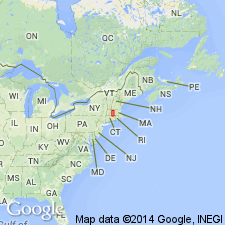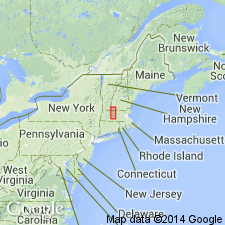
- Usage in publication:
-
- Fourmile Gneiss*
- Modifications:
-
- Overview
- AAPG geologic province:
-
- New England province
Summary:
Used as Fourmile Gneiss of Proterozoic Z to Ordovician age. Consists of layered to massive biotite-feldspar gneiss and amphibolite, ultramafic hornblendite, and muscovite quartzite.
Source: GNU records (USGS DDS-6; Reston GNULEX).

- Usage in publication:
-
- Fourmile Gneiss*
- Modifications:
-
- Age modified
- Overview
- AAPG geologic province:
-
- New England province
Summary:
Defined by Ashenden (1973). Corresponds in large part to Balk's (1956) border facies of Dry Hill Gneiss, although Balk (1956) as published by USGS differs considerably from Balk's manuscript on file at University of Massachusetts. Best available evidence is that contact with underlying Poplar Mountain Gneiss is sharp, so Late Proterozoic age is not necessarily implied. Unfortunately, best exposed contacts in tunnels of Northfield Mountain Pumping Storage Project at Northfield Farms are invaded by 10-m sill of quartz monzodiorite gneiss of Devonian Belchertown Complex (Robinson, unpub. data, 1980). This invalidates some of Ashenden's (1973) discussion of contacts. Fourmile Gneiss consists of biotite-feldspar gneiss and amphibolite, with one ultramafic hornblendite and three lenses of muscovite quartzite separately mapped. Overlain, with possible unconformity, by either Ammonoosuc Volcanics or Partridge Formation. Age is therefore uncertain but must certainly be Late Proterozoic, Cambrian, or Ordovician.
Source: GNU records (USGS DDS-6; Reston GNULEX).

- Usage in publication:
-
- Fourmile Gneiss
- Modifications:
-
- Geochronologic dating
- AAPG geologic province:
-
- New England province
Summary:
Swanzey, Pauchaug, Monson, and Fourmile Gneisses represent metamorphosed intrusive igneous rocks and yield ages from 454 to 442+3/-2 Ma. Therefore, ages range from early Late through latest Ordovician. Authors suggest that they represent the plutonic root of a calc-alkaline magmatic arc at least 250 km long that was produced partly or entirely on a continental margin in the Late Ordovician. The overlying Ammonoosuc Volcanics and Partridge Formation, rather than resting unconformably on these plagioclase-rich plutonic gneisses, are now known to have had a magmatic history overlapping with them and are approximately the same age.
Source: GNU records (USGS DDS-6; Reston GNULEX).
For more information, please contact Nancy Stamm, Geologic Names Committee Secretary.
Asterisk (*) indicates published by U.S. Geological Survey authors.
"No current usage" (†) implies that a name has been abandoned or has fallen into disuse. Former usage and, if known, replacement name given in parentheses ( ).
Slash (/) indicates name conflicts with nomenclatural guidelines (CSN, 1933; ACSN, 1961, 1970; NACSN, 1983, 2005, 2021). May be explained within brackets ([ ]).

